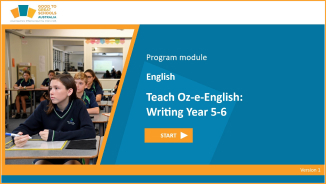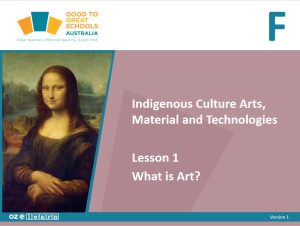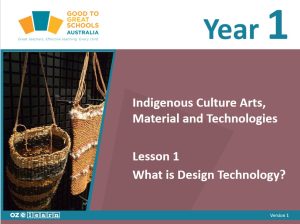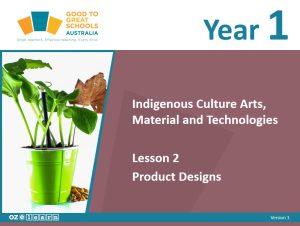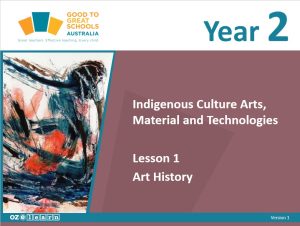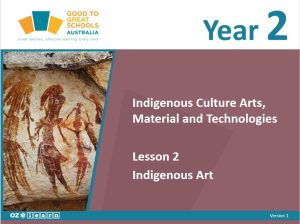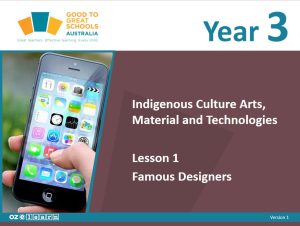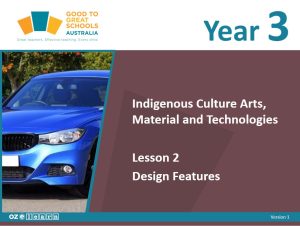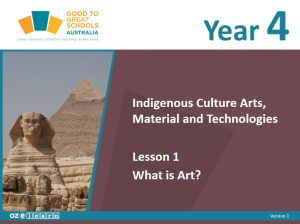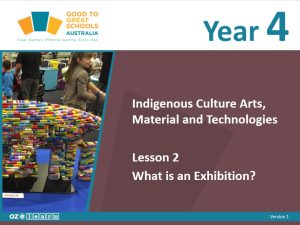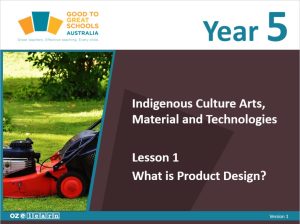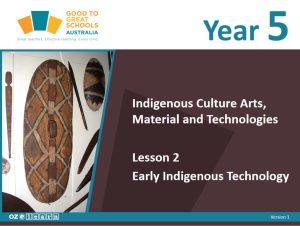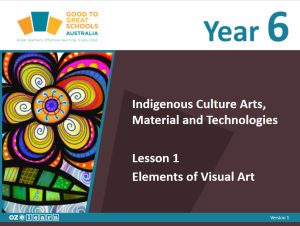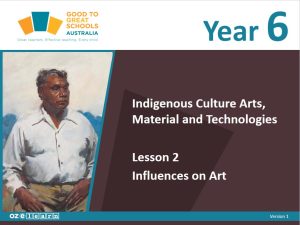Indigenous Culture Arts, Material and Technologies
Years F–6
Free Starter Lessons
Year Overview
Foundation Year – Exploring Art
Australian Curriculum Content Descriptions
Overview
Students explore what art is and what it can look like. They learn that anyone can be an artist. The elements of art are explored to develop an understanding of how artworks are created. Students learn that artists can express their ideas, observations and imagination through different techniques. They develop an awareness of what an art exhibition is and what it means to exhibit art.
Learning Objectives
In Lessons 1 to 17, students learn to:
- identify types of art
- identify where and why art is presented
- recognise the elements in art
- experiment with art techniques
- express ideas through drawing
- identify painting as art
- express imagination through painting
- express ideas through sculpture
- make patterns using prints
- identify fibres and experiment using fibres in art
- identify collage as art
- express ideas through collage
- identify digital images as art
- create art using digital images
- identify indigenous art
- describe artworks
- describe their own artworks
- express ideas through a group artwork
- prepare for their art exhibition.
Assessment
- Knowledge and Understanding Test (Lesson 18)
- Assessment Task: Art Exhibition (Lessons 14–17)
Complete This Unit
Lesson 1: Types of Art
Lesson 2: Exhibiting Art
Lesson 3: Elements of Art
Lesson 4: Art Techniques
Lesson 5: Drawing Art
Lesson 6: Painting Art
Lesson 7: Sculpting Art
Lesson 8: Print Making Art
Lesson 9: Fibre Art
Lesson 10: Collage Art
Lesson 11: Digital Image Art
Lesson 12: Indigenous Art
Lesson 13: Describing Art
Lesson 14: Describing my Art
Lesson 15: Group Art
Lesson 16: Group Art
Lesson 17: Exhibition Preparation
Year 1 – Exploring Design
Australian Curriculum Content Descriptions
Overview
Students investigate the technological change of products over time. They identify and describe the purpose, features and uses of traditional and modern technologies. Through investigation, students recognise different properties of materials and how they are joined. They identify that forces create movement in products. Following the design process, students meet the identified needs of users through the creation and modification of products.
Learning Objectives
In Lessons 1 to 17, students learn to:
- identify the five steps to designing a new product
- evaluate a product design
- identify early indigenous technologies
- describe how early indigenous technologies met needs
- recognise modified products
- identify whether products are new or modified
- design or modify a product to meet a need
- investigate a problem and brainstorm solutions
- make and test design solutions
- reflect on and communicate the results of product tests
- investigate materials and joins
- investigate a problem and brainstorm solutions
- model and test design solutions
- communicate the results of design solution tests
- identify that forces create movement in products
- investigate a problem and brainstorm solutions
- model and test design solutions
- communicate the results of design solution tests.
Assessment
- Knowledge and Understanding Test (Lesson 18)
- Assessment Task: Art Exhibition (Lessons 15–17)
Complete This Unit
Lesson 1: What is Design Technology?
Lesson 2: Product Designs
Lesson 3: Indigenous Technologies
Lesson 4: Modified Products
Lesson 5: New or Modified Products
Lesson 6: Thinking Like a Designer
Lesson 7: Problem 1: Investigate and Brainstorm
Lesson 8: Problem 1: Make and Test
Lesson 9: Problem 1: Reflect and Share
Lesson 10: Materials and Products
Lesson 11: Problem 2: Investigate and Brainstorm
Lesson 12: Problem 2: Model and Test
Lesson 13: Problem 2: Sharing results
Lesson 14: Forces and products
Lesson 15: Problem 2: Investigate and Brainstorm
Lesson 16: Group Art
Lesson 17: Exhibition Preparation
Year 2 – Creating Art
Australian Curriculum Content Descriptions
Overview
Students learn how their ideas or subject matter can be developed through different forms, styles, techniques, materials and technologies. They explore how and why artworks are created and ways to use and apply visual conventions such as line, shape, colour and texture. Students develop an understanding of how art can be effectively displayed at an exhibition. As a viewer, they respond to visual artworks and consider the artists’ intent and viewpoint, as well as their own. As an artist, they express their ideas through various creations and learn how to write an artist’s statement to welcome others to their art.
Learning Objectives
In Lessons 1 to 17, students learn to:
- describe where and why artworks are made
- recognise the elements of art
- identify ways to respond to and discuss artwork
- write an artist statement to introduce people to the art that has been created
- express ideas through drawing
- express imagination through painting
- express imagination through sculpting
- make patterns using prints
- identify fibres in art
- identify digital images as art
- express ideas through digital images
- identify collage as art
- express ideas through collage
- complete the end of unit task
- identify where and why art is presented
- prepare for their art exhibition.
Assessment
- Knowledge and Understanding Test (Lesson 18)
- Art Exhibition (Lesson 18)
Assessment Task: Art Exhibition (Lessons 14–17)
Complete This Unit
Lesson 1: Art History
Lesson 2: Indigenous Art
Lesson 3: Art Techniques
Lesson 4: Elements of Art
Lesson 5: Discussing Art
Lesson 6: Artists Statements
Lesson 7: Creating Drawings
Lesson 8: Creating Paintings
Lesson 9: Creating Sculptures
Lesson 10: Creating Prints
Lesson 11: Creating with Fibres
Lesson 12: Creating Digital Images
Lesson 13: Creating Collage
Lesson 14: Art Task
Lesson 15: Art Task
Lesson 16: Exhibiting Art
Lesson 17: Preparing for the Exhibition
Year 3 – Creative Designers
Australian Curriculum Content Descriptions
Overview
Students describe the contributions of designers over time. This includes designing products, services and environments that make people’s lives easier, safer and more comfortable. They will explore how materials and design features can be used to produce designed solutions that meet the needs of the community and the environment. Students will be involved in the design and technology processes and productive skills. They will investigate existing designs, explore needs for new designs, generate ideas, and select, test and use materials to make design examples, evaluate their ideas and processes and make changes where applicable. Following the design process, students meet the identified needs of users through the creation and modification of products.
Learning Objectives
In Lessons 1 to 17, students learn to:
- describe how designers contribute to our lives
- design features and describe their purpose
- give reasons for materials used in a design
- explain how Indigenous technology met needs
- investigate a local problem
- brainstorm design solutions to a problem
- write a production plan
- list safe work practices needed to make the design
- make design solutions
- test design solutions
- reflect on and evaluate design solutions
- share their design.
Assessment
- Knowledge and Understanding Test (Lesson 18)
- Assessment Task (Lessons 5–16)
Complete This Unit
Lesson 1: Famous Designers
Lesson 2: Design Features
Lesson 3: Properties of Materials
Lesson 4: Indigenous Technologies
Lesson 5: Investigators
Lesson 6: Investigators
Lesson 7: Brainstorming Ideas
Lesson 8: Brainstorming Ideas
Lesson 9: Production Plan
Lesson 10: Production Plan
Lesson 11: Safety
Lesson 12: Making Designs
Lesson 13: Making Designs
Lesson 14: Making Designs
Lesson 15: Testing
Lesson 16: Reflecting
Lesson 17: Sharing
Year 4 – Understanding Art
Australian Curriculum Content Descriptions
Overview
Students enhance their knowledge and experience of art. They extend their awareness of the elements of art and visual conventions utilised by artists. Through collaboration and communication of ideas, students plan and make artworks using visual conventions, techniques and processes. Engagement with professional artists develops students’ understanding of what an art exhibition is and what it means to exhibit art.
Learning Objectives
In Lessons 1 to 17, students learn to:
- recognise that art materials have changed over time
- recognise that exhibitions are held for different reasons
- recognise, describe and use design elements of art
- identify techniques and symbols in indigenous art
- identify the purpose and meaning of artwork
- make a traditional piece from natural materials
- use clay to make a coil pot
- identify different styles of Australian Indigenous art
- carve (or mould) an art piece to represent an indigenous totem
- identify and use indigenous symbols in their own artwork
- make prints using found objects to create a 2D art piece
- recognise how Indigenous art is used to tell stories
- collaborate to make an artwork
- curate a class art exhibition
- design an invitation to the class art exhibition
- finalise the necessary work for the art exhibition
- prepare and host an exhibition.
Assessment
- Knowledge and Understanding Test (Lesson 18)
- Assessment Task: Collaborative Artwork (Lesson 13), Art Exhibition (Lessons 14–17)
Complete This Unit
Lesson 1: What is Art?
Lesson 2: What is an Exhibition?
Lesson 3: Design and Elements of Art
Lesson 4: Techniques in Art
Lesson 5: Comparing Artworks
Lesson 6: Fibre Craft
Lesson 7: Clay
Lesson 8: Indigenous Art
Lesson 9: Sculpture
Lesson 10: Culture in Art
Lesson 11: Printmaking
Lesson 12: Stories Though Art
Lesson 13: Collaboration to Make an Artwork
Lesson 14: Planning an Exhibition
Lesson 15: Invitations
Lesson 16: Final Preparation
Lesson 17: Art Exhibition
Year 5 – Designing Solutions
Australian Curriculum Content Descriptions
Overview
Students investigate the technological change of products and environments over time. They identify and describe the competing considerations in the design of both traditional and modern products and environments. The contribution of design and technologies to meeting needs are also described. Students explain how the features of technologies impact of designed solutions. Following the design process, students meet the identified needs of users through the creation and modification of products and environments.
Learning Objectives
In Lessons 1 to 17, students learn to:
- design products by following a process
- evaluate early Indigenous technology and explain how it met needs
- explain how Indigenous products are modified to meet present and future needs
- identify whether a product is new or modified
- suggest criteria for a water saving system
- investigate different materials and how they can be joined
- identify and investigate a local issue
- brainstorm design solutions to a problem
- make and test design solutions
- evaluate and reflect on design solutions
- share test results and redesign products
- reflect on the project and their participation.
Assessment
- Knowledge and Understanding Test (Lesson 18)
- Assessment Task (Lessons 7–16)
Complete This Unit
Lesson 1: What is Product Design?
Lesson 2: Early Indigenous Technology
Lesson 3: Modified Indigenous Products
Lesson 4: Modified or New Design
Lesson 5: Thinking Like a Designer
Lesson 6: Materials and Products
Lesson 7: Investigating Issues
Lesson 8: Investigating Issues
Lesson 9: Brainstorming Solutions
Lesson 10: Brainstorming Solutions
Lesson 11: Modelling Products
Lesson 12: Modelling Products
Lesson 13: Evaluating Product Designs
Lesson 14: Evaluating Product Designs
Lesson 15: Communicate and Redesign
Lesson 16: Communicate and Redesign
Lesson 17: Reflection
Year 6 – What’s Your Story?
Australian Curriculum Content Descriptions
Overview
Students explore how time, culture and place influences art with a particular focus on these art forms: body art, body adornment pieces and digital photography. As an artist, they will use inspiration from traditional and contemporary art forms to create and express their ideas through various creations and will write an artist’s statement for each piece of work to welcome an audience to their art. As a viewer, they respond to their own and others’ artwork and consider the artists’ intent using key questions.
Learning Objectives
In Lessons 1 to 17, students learn to:
- recognise and explain how the elements of visual art can represent ideas
- describe the influences of artworks from different cultures, times and places on art making
- describe the elements of art and their purpose in Indigenous body art
- describe the elements of art and their purpose in contemporary body art
- identify traditional and contemporary art worn on the body
- create a digital artwork based on place
- create patterns and symbols that represent their place, time and culture
- identify the meaning in others’ artworks and create their own viewpoint
- experiment with different art forms
- identify where and how art is exhibited
- create artists statements to enhance the meaning of the artworks
- create an artwork based on their place, time and culture
- write an artist statement about their major work (personal pillar)
- prepare for their art exhibition.
Assessment
- Knowledge and Understanding Test (Lesson 18)
- Assessment Task (Lesson 18)
Complete This Unit
Lesson 1: Elements of Art
Lesson 2: Influences on Art
Lesson 3: Traditional Indigenous Body Art
Lesson 4: Contemporary Body Art
Lesson 5: Body Adornment
Lesson 6: Digital Art
Lesson 7: Personal Patterns and Symbols
Lesson 8: Responding to Art
Lesson 9: Experimenting with Different Art Forms
Lesson 10: Local Artist Visit
Lesson 11: Exhibiting Art
Lesson 12: Creating an Artist Statement
Lesson 13: Major Work
Lesson 14: Major Work
Lesson 15: Write and Artist Statement
Lesson 16: Finish Major Work
Lesson 17: Exhibition Preparation
Other Units
Lesson Design
Lesson Objective
Success Criteria
Activating Prior Knowledge
I Do
We Do
Apple Question
You Do
Revise
Professional Learning
